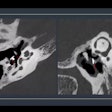A new study in the Journal of the American College of Cardiology found that patients with positive results on coronary artery calcium (CAC) CT scans made important lifestyle changes that led to lower risk profiles for cardiac events four years later.
"Patients who knew their coronary calcium scores improved their coronary heart disease risk compared with those with no scan, and those with high calcium scores were motivated to take even more aggressive steps to reduce their risk," said chief investigator Dr. Daniel Berman from Cedars-Sinai Heart Institute in a statement accompanying the results (JACC, April 12, 2011, Vol. 57:15).
The Early Identification of Subclinical Atherosclerosis by Noninvasive Imaging Research (EISNER) study assigned 2,137 volunteers to either undergo CAC scanning with CT (n = 1,424, 66%) or not to have the test (n = 713, 33.4%) prior to risk factor counseling. Scanning was performed using electron-beam CT (GE Healthcare) or MDCT (Siemens Healthcare). CAC scoring was performed using the Agatston method.
A total of 584 individuals who were not scanned and 1,256 subjects who were scanned completed the follow-up clinic evaluation and questionnaire. Compared with the volunteers who were not scanned, the scanned group showed an improvement in systolic blood pressure, low-density lipoprotein cholesterol, and waist circumference for those with increased abdominal girth. There was also a tendency for weight loss among overweight subjects at follow-up four years later.
Both groups started the EISNER study with Framingham risk scores of 6%. The researchers found that in the no-scan group, individuals experienced a rise in the mean Framingham risk score of 0.7 percentage points, with a standard deviation of ± 5.1. However, in the group that was scanned, Framingham scores only rose 0.002 percentage points, with a standard deviation of ± 4.9 (p = 0.003). Within the scan group, increasing baseline CAC scores were associated with improvements in systolic and diastolic blood pressure, total cholesterol, LDL cholesterol, triglycerides, and weight.
Medical testing and costs were similar in both groups. Patients with normal baseline scans had fewer tests and procedures in the subsequent four years, compared with the no-scan patients. Drug costs were 7% higher in the scan group owing to their use of blood pressure and cholesterol-lowering medications, the authors wrote.
Compared with no scanning, the study found that CAC scanning was associated with better risk factor control without increasing downstream medical costs.
"A large number of studies has consistently shown that coronary calcium scanning adds to standard risk factor assessment in predicting heart attacks and cardiac death. By showing improved patient outcomes with scanning -- without increasing the need for subsequent tests -- the EISNER study will be very helpful in our quest to prevent heart attacks," Berman said. "The test isn't for everyone, but should be considered in patients with risk factors for coronary artery disease who are in the right age group."



















